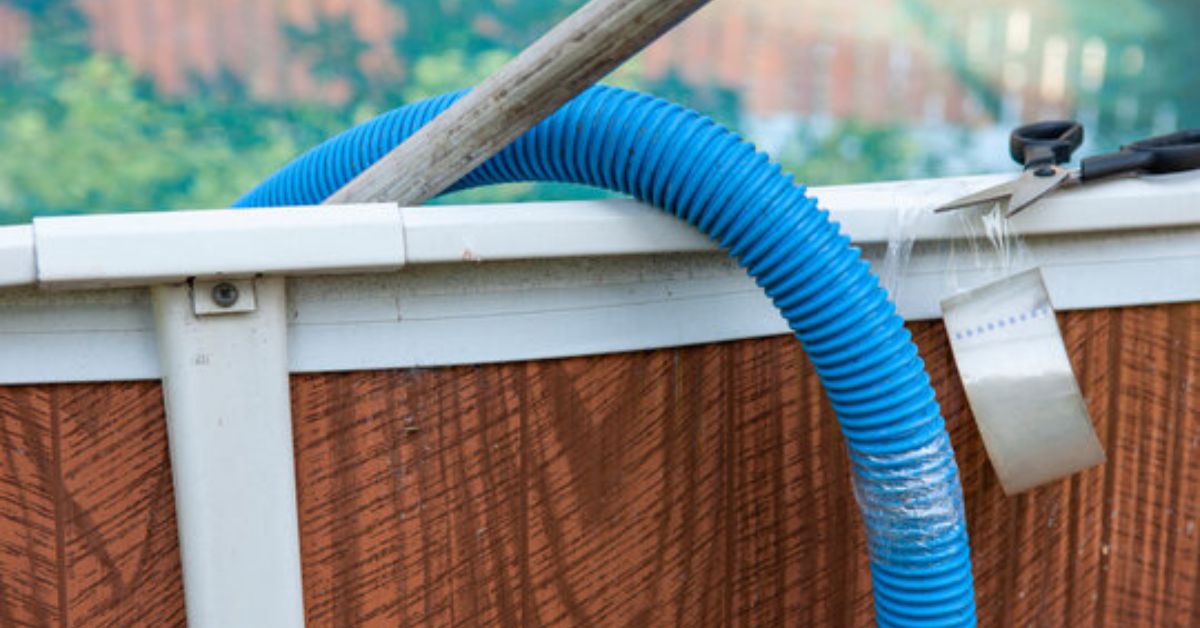An above ground pool offers endless summer fun, but the frustration of a mysterious leak can quickly dampen your enjoyment. Don’t let the idea of a leak in pool liner put a damper on your poolside paradise – armed with the proper knowledge, you can quickly identify and address the issue.
An above-ground pool’s potential for leakage is one of its main drawbacks. Since pool liners are often composed of thin vinyl, they are easily punctured by anything with sharp edges and can even become worn out from repeated exposure to the chemicals in the water.
Learning the cautioning signs of a leak is crucial because pool leaks can be quickly fixed if you catch them early. In this guide, our pool builders in PA walk you through the step-by-step process of detecting leaks in your above ground pool and providing the necessary solutions to keep the water where it belongs.
Before Starting on How to Find Leak in Pool Liner
A leak can only originate from a few places, including machinery, plumbing lines, and penetration points. Before you touch anything, please notice how they are all doing. Also, keep an eye on the water level, as this will reveal where or what the leak may be coming from. If possible, estimate how many days it took from when the pool was filled to a given height for significant leaks to become visible.
Detect And Repair: Finding Leak in Pool Liner
1. Visual Inspection
Begin by thoroughly inspecting the pool liner, walls, and the area around the pool. Look for any visible cracks, tears, or gaps that could be causing the leak. Pay close attention to seams, corners, and accessories like skimmers or return jets.
2. Water Level Monitoring
Mark the current water level with tape and monitor it over 24 hours. A significant drop in water level could indicate a leak. Ensure that evaporation and splashing are taken into account during your observation.
3. Bucket Test
Conduct a pool leak detection test to determine if evaporation is a factor. Fill a bucket with water and place it on the pool steps or another flat surface. Mark the water level inside the bucket and the pool water level. After 24 hours, compare the water loss in the bucket to the pool. A leak is likely if the pool water level drops significantly more than the buckets.
4. The Food Coloring Method
For pinpointing more minor leaks, the food coloring method is effective. With the pool pump off, add a few drops of food coloring near suspected leak areas – seams, corners, and accessories. If the food coloring is drawn into the pool, it indicates the presence of a leak.
5. The Dye Test
Use a dye specifically designed for above ground pool leak. Squirt the paint around suspected leak sites while the pool pump is off. Observe if the shade is pulled into any openings, indicating a leak.
6. The Pump Test
Turn off the pool pump and observe the water level over the next 24 hours. If the water loss continues despite the pump being off, the issue likely lies within the pool structure.
7. Professional Assistance
If you cannot locate the leak after these DIY methods, it’s time to call in the experts. A professional pool technician can perform a pressure test to categorize the exact location of the leak.
8. Repairing the Leak
Once the leak in pool liner is located, repair it promptly. For minor tears or holes, use a pool repair patch kit. More significant leaks may require a professional touch, especially if they involve structural damage or complex repairs.
9. Pressure Testing
If the source of the leak remains elusive, a pressure test can be the best way to find the leak in the pool liner. A pressure test involves using specialized equipment to pressurize your pool’s plumbing lines. This helps identify leaks in the pipes, connectors, or fittings that might contribute to water loss.
10. Soil Moisture Check
Sometimes, leaks can be a result of the surrounding soil conditions. If your pool is set up on uneven ground or soil with poor drainage, it might be causing water to seep out. Inspect the area around your pool for signs of overly damp soil, which could indicate a leak occurring below ground level.
11. Professional Leak Detection Services
For persistent or complex leaks, enlisting the expertise of a professional finding leak in above ground pool service is a smart move. These professionals use advanced technology like electronic listening devices and thermal imaging to pinpoint even the trickiest leaks.
12. Preventive Measures
Consider preventive measures to avoid future leaks once you’ve identified and fixed the leak. Habitually inspect your pool for signs of wear, address minor issues promptly, and maintain proper water chemistry to prevent deterioration of the pool liner and equipment.
13. Monitoring and Maintenance
Regularly monitor your pool’s water level even after finding a leak in the pool liner. This ensures that the repair was successful and that no new leaks have developed. Maintaining routine maintenance, such as cleaning, balancing water chemistry, and inspecting equipment, will help minimize the risk of leaks and other pool-related issues.
Principal Lessons – Pool Leak Detection
- To discover leaks, carefully inspect the entire pool, including the pool equipment.
- Check the area around the pool for leaks in the vinyl liner, but if you still can’t discover one, try the bucket approach or the ink method.
- Once you’ve located the pool leak, use patch kits, vinyl patches, waterproof tape, and vinyl patches.
In Closing
Combining the DIY methods and seeking professional assistance, when necessary, you can confidently tackle the challenge of how to find a pool leak in your above-ground pool. Remember that timely action not only saves water but also preserves the enjoyment of your collection for seasons to come.
A little vigilance and preventive care ensure that your above ground pool remains a source of fun and relaxation, free from the worry of leaks.
With this comprehensive pool maintenance checklist, you can confidently detect and address leaks in your above-ground pool. Remember that timely detection and repair save water and money and ensure you enjoy your pool season without dealing with leaks.
A well-maintained pool guarantees more time to soak, swim, and create cherished memories in your private aquatic haven.
Frequently Asked Questions
1. What is the easiest way to find a leak in an above ground pool liner?
One of the easiest methods involves visually inspecting the pool liner. Look for visible tears, holes, or gaps in the liner material. If the leak is more extensive, it may be noticeable upon inspection.
2. How do you find a leak in a pool without draining it?
You can find a leak in an above ground pool without draining it by utilizing methods like the bucket, food coloring, or dye tests. These methods allow you to identify leaks while the pool is still filled with water, saving you the hassle of draining the pool unnecessarily.
3. What is the most common above ground pool leak?
One of the most common sources of leaks in above ground pools is the pool liner itself. Liners can develop tears, holes, or punctures due to wear and tear, sharp objects, or even shifts in the ground. Regular inspections and prompt repairs can address this common issue.
4. How do I find a leak in my above-ground pool with food coloring?
To find a leak using food coloring, turn off the pool pump and add drops near suspected leak sites, such as seams, corners, or around accessories. If the food coloring gets drawn into the pool, it indicates the presence of a leak and helps you pinpoint its location.
As you navigate the above ground pool leak detection world, these FAQs can provide valuable insights to identify and address leaks efficiently. Whether using visual inspections, DIY tests, or seeking professional assistance, timely leak detection ensures that your pool remains enjoyable without worrying about water loss.






